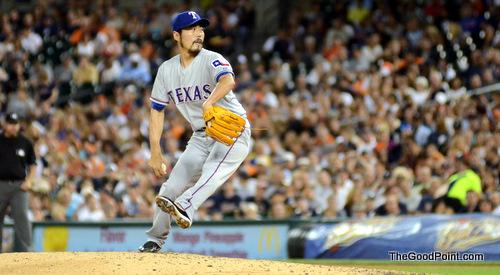
Found in translation: Koji Uehara ready for Texas
Few baseball fans know a lot about Koji Uehara, but the Texas Rangers knew exactly what they were getting when they acquired the Japanese right-hander at the trade deadline at the end of July: one of the best relief pitchers in baseball.
People are only starting to realize just how effective Uehara has been this season, and that effectiveness certainly comes with a price, as the Rangers shipped youngsters Tommy Hunter and Chris Davis – along with their years of team control – to the Baltimore Orioles in order to get the deal done.
For the Rangers, adding Uehara immediately addressed a glaring need in the bullpen, but to the Japanese righty, even more glaring was going from a Baltimore team that ranked worst in the American League to a division-leading Texas club more than equipped for a deep postseason run.
“I never had a chance to contend with the Orioles, so now that I have this team where they’re competing for the pennant, I’m really excited to be a part of it,” Uehara exclusively told The Good Point through his translator.
Uehara has become one of the most fascinating pitchers to watch this season, and considering he made his Major League debut in 2009 with the Orioles at the age of 34, he has also been one of baseball’s most fascinating stories.
Few players are able to go from successful to purely dominant in a short time period, but that’s exactly what Uehara has done since finding his true calling as a reliever following the 2009 season.
[php snippet=1]
Last season, his first as a full-time reliever, Uehara finished with a 2.86 ERA (2.40 FIP) and 0.955 WHIP in 44 innings of work. He limited opposing hitters to a .220 average, thanks to an ability to constantly pound the strike zone and force hitters to make contact on his pitches. His average of one walk per nine innings unbelievably contrasted his 11.3 strikeouts per nine frames, and he actually finished with more strikeouts last year than he did in 2009 when he threw 22 more innings.
For pitchers, the age-old saying is that if you retire the leadoff batter in an inning, it makes your life a lot easier. Uehara has always incorporated that when he’s on the mound, but even more so last season, when he limited the first batters he faced to a mere .140 average. Add that to the fact he threw 66% first-pitch strikes and absolutely dominated right-handed hitters, and it was easy to see why the Orioles were reluctant to part with the Osaka native at this year’s trade deadline.
What’s fascinating about Uehara is that he is so successful despite not possessing overpowering velocity. His fastball rarely touches 90 mph, but his diverse pitch repertoire and exceptional command make him a force on the mound; so much so that he was actually able to improve on last season’s already-dominant numbers in 2011.
In 47 innings of work prior to the trade, Uehara allowed just eight walks and nine earned runs (1.72 ERA), to go along with 62 strikeouts. He’s also started to rely more on a splitter, which has helped convince more hitters to swing at pitches outside the strike zone, and in turn reach new career-highs in both ground ball and swinging strike percentages.
Considering that it was with Baltimore where Uehara emerged as such a dominant player, it’s no surprise that it was hard for him to deal with the news that he was traded from the only Major League organization he has ever been a part of.
“At first it was a bittersweet feeling that I had to leave the team that I loved playing for, so it was kind of sad,” Uehara said. “But at the same time I had to change my mindset the next day to come here for a new team to prepare for the games.”
Even though he’s 36 years old, Uehara’s pitching could earn him a contract for multiple years down the road. That’s just fine to the Rangers, as Uehara will provide stability in their bullpen for years to come and could even step in as their future closer should they ever decide to move incumbent Neftali Feliz into the starting rotation.
In his move to the Rangers’ clubhouse, Uehara was also reunited with a familiar face. Fellow reliever Yoshinori Tateyama was a high school teammate back in Japan, and there’s even speculation that the newfound Japanese contingent that Tateyama and Uehara make up could even be a ploy to lure highly-touted Japanese free agent starter Yu Darvish to the Lone Star state.
While it’s nice to be reunited with a friend and former teammate in Texas, Uehara’s simple game plan remains the exact same as it was in Baltimore.
“Whenever they call my name, just prepare, perform, and produce. That’s all I can do.”
[php snippet=1]

